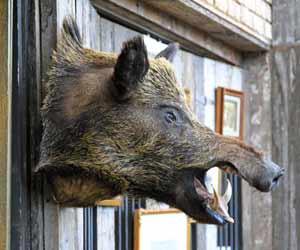Taxidermist Jobs
Have you seen a dead animal preserved? Maybe you’ve seen a swordfish on your uncle’s mantle, a mammoth grizzly bear towering over you in a museum, or an elk head on the wall of a restaurant. Sometimes you might even think the animal is still alive, but it’s not. Do you know how these animals get mounted? A taxidermist does it.
Taxidermists love working with animals and have a solid understanding of nature. It is their job to prepare, stuff, and mount animals in a three dimensional lifelike form as a trophy for hunters, museums, homes, educational institutions, businesses, or restaurants. It’s a really cool job for any true fan of wildlife. Taxidermists are professional artists who must have good hand-eye coordination and a strong attention to detail.

As long as you aren’t totally grossed out by exploding eyeballs, gloppy sticky blood, brains oozing onto your shoes, or fat dribbling down onto the floor then consider taxidermy as a career. That’s right – you’ll be elbows deep in animals, so get ready to make a mess. Taxidermists need to work in a place that can get messy and be cleaned easily. They often work from home.
Most taxidermists start this job as a hobby. Begin with a mail order kit, then develop your talent with the neighbor’s latest deer kill. Remember that experience is the key to success. You can gain experience by apprenticing or attending taxidermy schools. While officially no formal education is required, there are a number of good taxidermy schools all over the world. Usually they are licensed and bonded and last from 2 to 12 weeks or more. They include academics and lab work and can cost in the thousands of dollars. However you go about learning this craft you will have to obtain a state-issued license to practice taxidermy.
A taxidermist’s daily grind is cool. You meet with a client, usually a hunter, and discuss the animal, positions, fees, and timelines. You may mount ducks, deer, fish, bears, shark, elk, moose, goats, turtles, alligators or even people’s pets. There are many techniques and methods to preserve and mount animals, but overall each job is similar. You’ll be using knives, scalpels, and chemicals. You clean it, skin it, remove meat, bones, and fat, measure body size, wash away blood and grease, dry it, preserve it, and create an artificial body. This process can take days.
Making the animal look lifelike is the true taxidermy talent. It means using glass eyes, matching fur colors, repairing damage, and creating correctly proportioned bodies. It’s a challenge because every animal is different. Your work is your portfolio and that’s what will bring in loyal, repeat customers.
The best customers are private individuals or museums. As you can imagine, hunters make up a huge percentage of the work. Most taxidermists are hunters too. Often you can set your schedule so that you spend your mornings in a duck blind and then 9 or 10 hours of the day listening to music and mounting ducks.
Taxidermists make on average $41,000 per year. This depends on location and talent. Almost always taxidermists make their money per mount. Mounts can be around $500 for a deer head to several thousand dollars for a brown bear. The more work you do, the more money you make.
No matter what you are working with – fins, feathers, or fur – taxidermy is a unique job. Every time you prepare, stuff, and mount an animal you’ll make money, but you’ll also make someone’s day.
Quick Facts About Taxidermy Jobs
Job Title: Taxidermist
Office: Home or Business – Some place you can get really messy
Description: Skin, preserve, stuff, and mount dead animals into a lifelike appearance
Certifications/Education: No formal education required. Taxidermy school highly recommended, licensed by State
Necessary Skills: Attention to detail, hand-eye coordination, artistic
Potential Employers: Museums, Hunters, Self-Employed
Pay: Pay per mount, Average $41,000 per year
Helpful Taxidermist Employment Links:
Search Taxidermist Jobs on JobMonkey
National Taxidermists Associations
Taxidermy Association Directory
Taxidermy.net
Taxidermy Today Magazine
United Taxidermist Association
List of Taxidermy Schools


 Teach English in Asia
Teach English in Asia  Cruise Ship Jobs
Cruise Ship Jobs  Alaska Fishing Industry Jobs
Alaska Fishing Industry Jobs  Sharing Economy / Gig Economy
Sharing Economy / Gig Economy